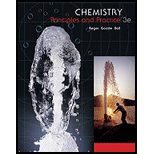
Concept explainers
(a)
Interpretation:
The molarity of
has to be calculated.
(a)
Answer to Problem 4.43QE
The molarity of
Explanation of Solution
Given: Volume of solution is
Conversion of mass into moles:
By substituting the given data into the molarity formula,
Therefore,
The molarity of
(b)
Interpretation:
The molarity of
has to be calculated.
(b)
Answer to Problem 4.43QE
The molarity of
Explanation of Solution
- Given information as follows,
Molarity and volume of
Now apply
By substituting into the relation, the volume is calculated as shown below,
Therefore,
The molarity of
Want to see more full solutions like this?
Chapter 4 Solutions
Chemistry
- What is the molarity of a glucose (C6H12O6) solution prepared from 55.0 mL of a 1.0 M solution that is diluted with water to a final volume of 2.0 L?arrow_forwardInsulin is a hormone that controls the use of glucose in the body. How many moles of insulin are required to make up 28 mL of 0.0048 M insulin solution?arrow_forwardHeme, obtained from red blood cells, binds oxygen, O2. How many moles of heme are there in 150 mL of 0.0019 M heme solution?arrow_forward
- You want to prepare a 1.0 mol/kg solution of ethyleneglycol, C2H4(OH)2, in water. Calculate the mass of ethylene glycol you would need to mix with 950. g water.arrow_forwardOne mole of CaCl2 is represented as where represents Ca and represents Cl. Complete the picture showing only the calcium and chloride ions. The water molecules need not be shown. What is the molarity of Ca2+? of Cl-?arrow_forwardConsider a 13.0% solution of sulfuric acid, H2SO4,whose density is 1.090 g/mL. (a) Calculate the molarity of this solution. (b) To what volume should 100. mL of this solution bediluted to prepare a 1.10-M solution?arrow_forward
 Chemistry: Principles and PracticeChemistryISBN:9780534420123Author:Daniel L. Reger, Scott R. Goode, David W. Ball, Edward MercerPublisher:Cengage Learning
Chemistry: Principles and PracticeChemistryISBN:9780534420123Author:Daniel L. Reger, Scott R. Goode, David W. Ball, Edward MercerPublisher:Cengage Learning Chemistry: Principles and ReactionsChemistryISBN:9781305079373Author:William L. Masterton, Cecile N. HurleyPublisher:Cengage Learning
Chemistry: Principles and ReactionsChemistryISBN:9781305079373Author:William L. Masterton, Cecile N. HurleyPublisher:Cengage Learning World of Chemistry, 3rd editionChemistryISBN:9781133109655Author:Steven S. Zumdahl, Susan L. Zumdahl, Donald J. DeCostePublisher:Brooks / Cole / Cengage Learning
World of Chemistry, 3rd editionChemistryISBN:9781133109655Author:Steven S. Zumdahl, Susan L. Zumdahl, Donald J. DeCostePublisher:Brooks / Cole / Cengage Learning Chemistry: The Molecular ScienceChemistryISBN:9781285199047Author:John W. Moore, Conrad L. StanitskiPublisher:Cengage Learning
Chemistry: The Molecular ScienceChemistryISBN:9781285199047Author:John W. Moore, Conrad L. StanitskiPublisher:Cengage Learning General Chemistry - Standalone book (MindTap Cour...ChemistryISBN:9781305580343Author:Steven D. Gammon, Ebbing, Darrell Ebbing, Steven D., Darrell; Gammon, Darrell Ebbing; Steven D. Gammon, Darrell D.; Gammon, Ebbing; Steven D. Gammon; DarrellPublisher:Cengage Learning
General Chemistry - Standalone book (MindTap Cour...ChemistryISBN:9781305580343Author:Steven D. Gammon, Ebbing, Darrell Ebbing, Steven D., Darrell; Gammon, Darrell Ebbing; Steven D. Gammon, Darrell D.; Gammon, Ebbing; Steven D. Gammon; DarrellPublisher:Cengage Learning





